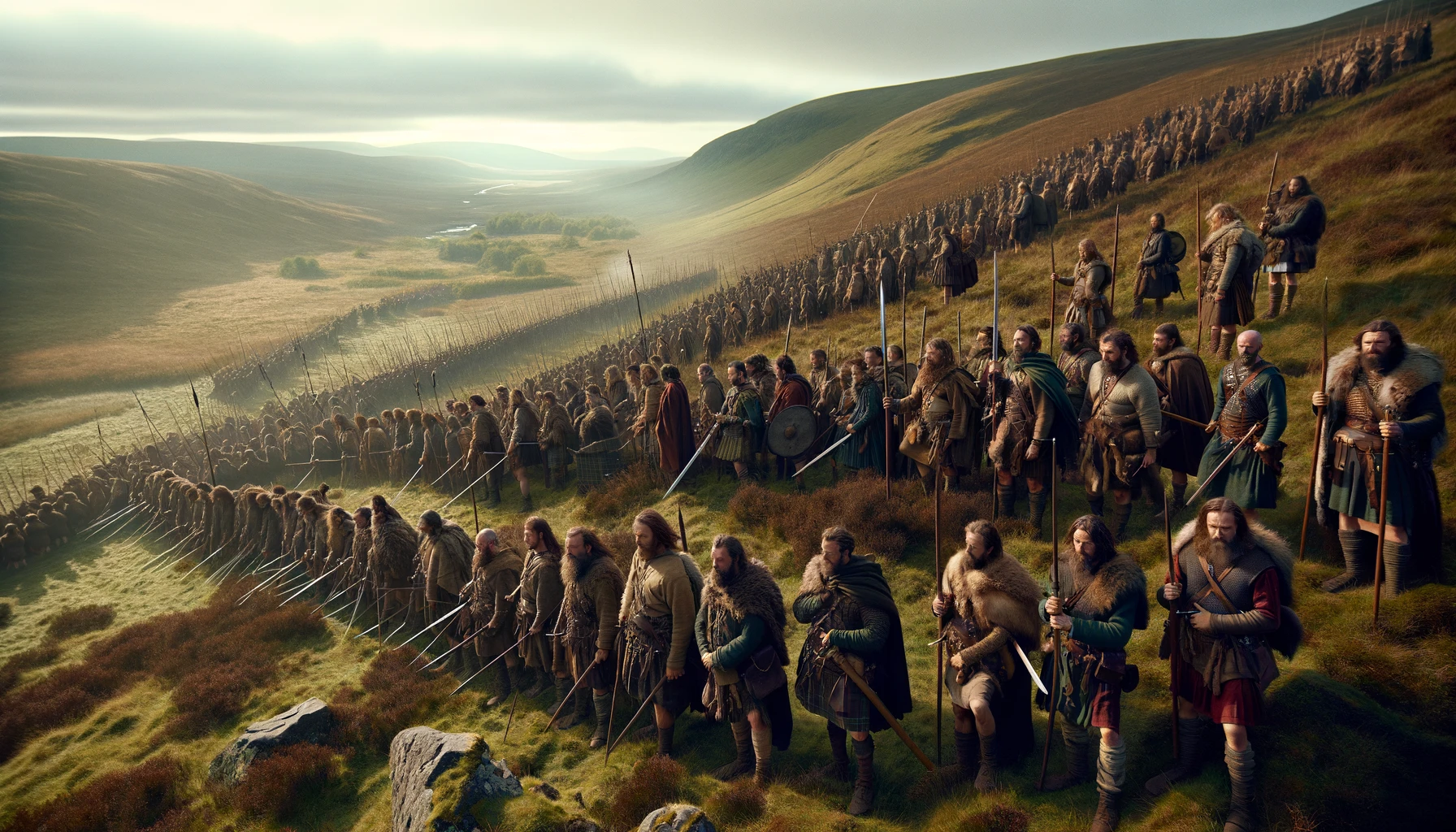While Tacitus does not record any specific events in Britain during the winter of AD 82, it is reasonable to assume that construction and maintenance of Roman military sites continued vigorously. This would be particularly true for the garrisons along the Strathmore road at locations like Ardoch, Strageath, and Bertha, where maintaining strong defences would have been a priority. Simultaneously, ongoing work on the legionary fortress at Deva is evidenced by the dated official stamps on water pipes laid in AD 79, during the respective ninth and seventh consulships of Emperor Vespasian and Titus, and while Gnaeus Julius Agricola served as the emperor’s propraetorian legate.
The Caledonian Tribes Gather their Forces
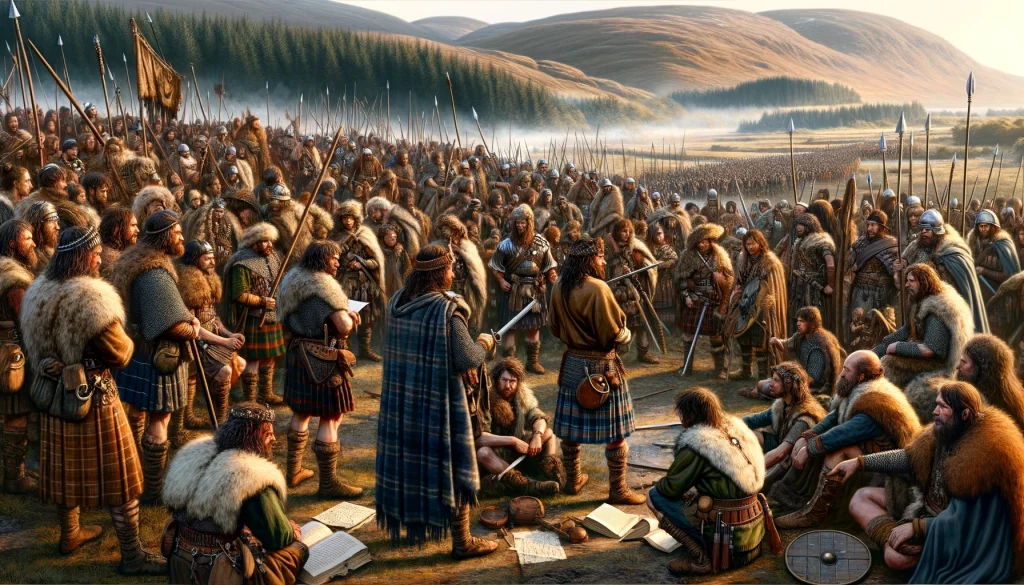
Meanwhile, the Caledonian tribes, realizing the inevitability of conflict, started to unify their forces. Tacitus notes their understanding that a shared threat necessitated a joint response (Agr. 29.3). Thus, they dispatched emissaries to forge or renew alliances, leading to a significant gathering of the Caledonian tribes. Tribes such as the Venicones, Taexali, and Vacomagi, who had direct encounters with Roman forces, joined others like the Cornavii and Creones (who we only have a single mention of them by the geographer Ptolemy), who may have required more persuasion to join the war effort. Tacitus claims that over 30,000 warriors responded, although this figure is subject to debate. These warriors, noted for their battle honours and possibly wearing traditional Celtic decorations such as bronze armlets and torcs, would have presented an imposing sight, reminiscent of the Celtic warriors described by Polybius centuries earlier (Plb. 2.29.8).
The selection of the battlefield, according to Tacitus, was a strategic decision by the Caledonians, based on central location, distinctive topography for easy identification, and suitable terrain for chariot use. Mons Graupius met all these criteria, and the site of Bennachie aligns well with these requirements. This account is taken from the Codex Aesinas, specifically folio 60 recto, where Tacitus first mentions Mons Graupius.
Agricola Marches to the Battle
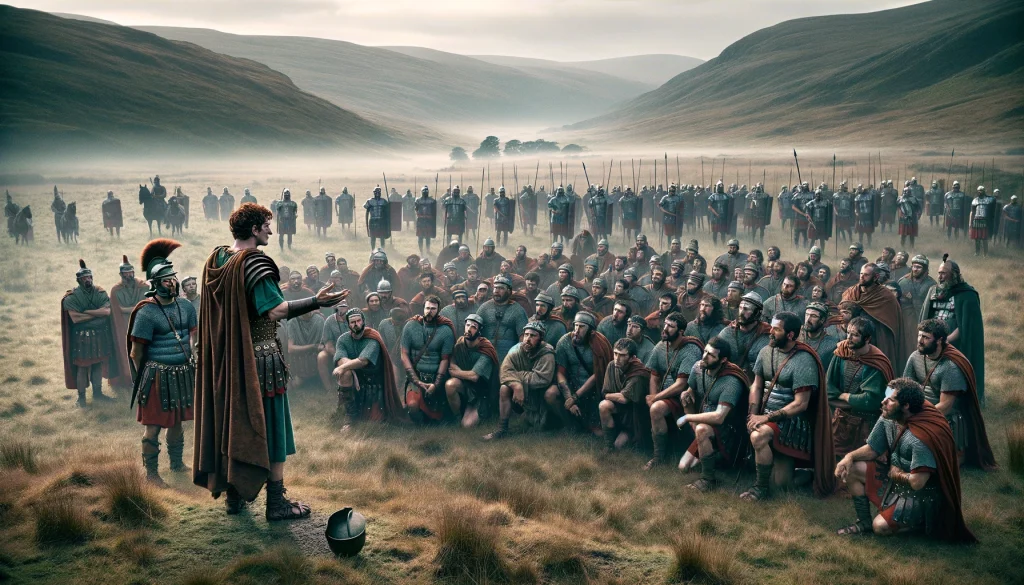
In his account of the Battle of Mons Graupius, Tacitus portrays his father-in-law, Agricola, empathizing with his troops on the morning of the battle. Agricola recalls the soldiers’ eager anticipation for combat during challenging marches across marshes, mountains, and rivers, quoting them saying, “When will we get at the enemy? When shall we have a battle?” (Tac., Agr. 33.4). This desire for a decisive confrontation was fuelled by a yearning to avenge the Caledonians’ night assault on the Legio IX Hispana and to assert the conquest of Caledonia conclusively.
The path of Agricola’s march was largely influenced by the landscape. From Camelon on the Forth–Clyde isthmus to the River Tay at Perth, the route was constrained by the Highland front, a path still mirrored by today’s A9 highway. However, unlike the modern highway that traverses the Grampians towards Inverness, Agricola’s forces likely followed a more coastal route to stay in contact with the fleet. This is evidenced by the location of the Raedykes Camp near Stonehaven Bay. Tacitus describes Agricola sending the fleet ahead to create chaos and fear through plundering, while he led the army, lightened of baggage and bolstered by the bravest Britons, to Mons Graupius, already occupied by the enemy (Tac., Agr. 29.2).
Upon reaching Mons Graupius, Agricola reflects on the arduous campaign, with Tacitus quoting him: “it is noble and splendid to have accomplished such a long march, bypassing forests and crossing estuaries” (Agr. 33.5). However, he also warns of the dangers of a potential retreat, given the lateness of the season and the challenges posed by an undefeated enemy behind them. Tacitus notes that ‘the summer was already over’ following the battle (Agr. 38.2).
Agricola’s army was notably without a baggage train (expeditus), suggesting a strategic decision for speed and flexibility, possibly with the wagons following under separate guard. Roman armies typically marched in a formation that allowed them to be ready for both travel and battle, as described by Onasander in “The General” (Strategikos), a work dedicated to Quintus Veranius, a former legate of Britain. Onasander advised that an army should advance “prepared at the same time for marching and for battle” (Strat. 6.1), aligning with Agricola’s approach of expeditus.
Common Roman Approaches to Battle
Onasander, in his military treatise, emphasizes the importance of cavalry scouts for reconnaissance ahead of the main force. He advises that a marching formation should be compact, rectangular, and not excessively long for ease of management and safety (Strat. 6.5). He also suggests placing medical equipment and baggage in the center, although it seems Agricola’s army might have lacked these when he arrived at Mons Graupius. There, he deployed 8,000 auxiliary infantry and 5,000 cavalry, with the size of his legionary force likely comparable to the auxiliary infantry.
Drawing a parallel to another military campaign, about 50 years later in Cappadocia, Governor Arrian’s preparations against a potential invasion offer insights into typical Roman army formations. Arrian’s force, as detailed in “The Expedition against the Alans” (Ectaxis kat’Alanon), also used cavalry scouts in line with Onasander’s recommendations. His army formation began with cavalry, followed by auxiliary infantry including archers, then the general and his mounted bodyguard, the legionary cavalry, more auxiliary and allied infantry, and finally additional cavalry units safeguarding the rear and flanking the marching column.
Arrian’s smaller army, comprising elements like the XV Apollinaris and XII Fulminata legions, stretched almost 6km (4 miles) long. Agricola’s force, likely larger, could have extended twice as far. This means that as Agricola’s rear guard was leaving Kintore, his advance team might have already been setting up the next camp at Durno, near the peaks of Bennachie. Such an arrangement underlines the logistical complexities and the scale of Roman military operations during their campaigns, like Agricola’s march to Mons Graupius.
Agricola’s Battle Speech
The tradition of a general addressing his troops before battle is a longstanding feature of ancient warfare, exemplified by leaders like Alexander the Great before the battles of Issus and Gaugamela (Curt., Hist. Alex. 3.10; 4.14), Hannibal and Scipio Africanus before Zama (Plb. 15.10–11), and Caesar before Pharsalus (Caes., BCiv. 3.90).
As Agricola’s forces were preparing for the Battle of Mons Graupius, Tacitus depicts Agricola delivering a motivational speech to his already eager troops. Agricola’s words, as recorded by Tacitus, emphasize the accomplishments of the Roman Empire in Britain and the subjugation of the land to Roman control (Tac., Agr. 33.1–3). However, Professor Ogilvie, in his commentary on Agricola, cautions that while Agricola likely made a speech, the exact words preserved by Tacitus may not be entirely accurate.
It is almost certain that Agricola did address his troops, as it would have been unusual for a general not to do so at such a critical moment. Onasander, in his work on strategy, underscores the importance of a general’s speech in boosting morale and instilling a desire for glory in the soldiers (Onas., Strat. 1.13). While the precise content of Agricola’s speech is uncertain, Tacitus’ rendition might have been more his own creation than a verbatim record. Plutarch, discussing the grandiose battle speeches recorded by historians, suggests that such rhetoric is unlikely in the face of imminent combat (Plut., Moral. 803B).
Practically, addressing an entire army of around 20,000 men simultaneously would have been challenging. Alexander the Great, for example, is said to have ridden along his army’s front, speaking to individuals and units personally (Arrian, Anab. 2.10; Curt., Hist. Alex. 3.10). Agricola could have employed a similar approach, particularly as Tacitus suggests that he addressed the troops as they were almost bursting from their defences, eager for battle.
Roman Battle Deployment
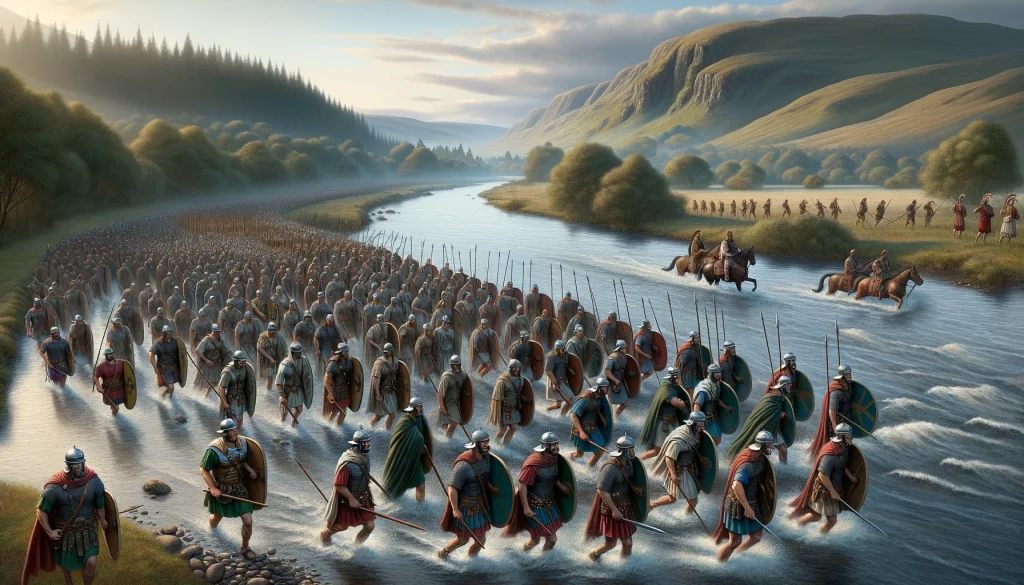
After Agricola’s speech, there was a tremendous surge of enthusiasm among the troops, who immediately geared up for battle (Tac., Agr. 35.1). We can imagine the Roman soldiers streaming out of the west and south gates of the Durno camp, crossing the River Urie to form their battle lines. Agricola arranged his forces with 8,000 auxiliary infantry at the centre and 3,000 cavalry on the flanks. The legions were positioned in front of the rampart, not initially engaged in the battle, a strategy interpreted by Tacitus as an attempt to win without spilling Roman blood (Tac., Agr. 35.2).
However, this view of sparing Roman blood seems more like Tacitus’ interpretation than a reflection of Roman military thinking. Both auxiliaries and legionaries were integral parts of a professional army, each with their unique strengths and weaknesses. The idea that auxiliaries were expendable or less valued, a perspective that previous scholars may have held, is not supported beyond Tacitus’ comment.
Agricola’s reliance on auxiliary troops for the battle line, rather than the legions, has puzzled scholars. It’s clear he trusted their capability, with Tacitus later noting their training and experience (Agr. 36.1). Unlike the common misconception of auxiliaries as ‘light infantry,’ many were as heavily armed as legionaries. For example, while legionaries typically wore the lorica segmentata cuirass, auxiliaries often donned the heavier lorica hamata mail shirt, and they were similarly equipped with helmets, shoes, and oval shields.
Notably, a significant portion of Agricola’s infantry, perhaps 3,000 of the 8,000, were Batavians and Tungrians, known for their exceptional martial skills, originally hailing from the Rhine delta. These units might have included recruits from Britain, preserving their native fighting traditions. They had previously demonstrated their prowess during the assault on Anglesey in AD 77, notably with their river-crossing skills. While the River Urie at Durno wasn’t as challenging as the Menai Straits, Agricola likely had specific reasons for deploying these troops in this battle, a point worthy of further exploration.
Caledonian Battle Deployment
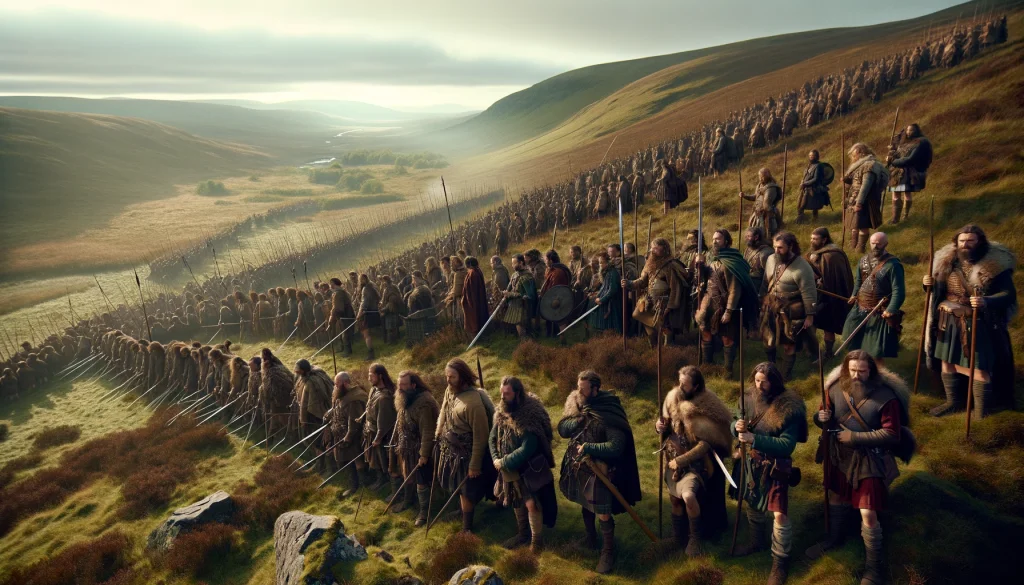
The Caledonians were also getting ready for battle, positioning themselves strategically to exploit the topography of Bennachie, likely amid the sound of war horns. Tacitus describes their formation: the Britons were arrayed on elevated ground for impact and intimidation, with the front ranks on the plain and others ascending the hill in a curving formation. The charioteers occupied the central plain, creating noise and spectacle as they maneuverer (Tac., Agr. 35.3).
St Joseph noted that Bennachie’s northern face forms a vast amphitheater facing the Durno camp, spanning about 3.5km (2 miles). The Caledonians, positioned in a curving formation on the hillside, overlooked the plain where numerous chariots roamed, aiming to daunt the Roman lines with their noise and movements. These chariots, likely piloted by chieftains showcasing their skills, primarily aimed to cause damage by running along the Roman front ranks.
Classical scholar Stan Wolfson observed a parallel in Silius Italicus’ poetry, possibly inspired by Tacitus’ account of the Battle of Mons Graupius. Tacitus also recounts Agricola’s concern about the Caledonians’ superior numbers potentially attacking simultaneously from the front and sides. Thus, Agricola extended his ranks, despite advice to deploy the legions, and joined his men on foot in front of the standards (vexilla) (Tac., Agr. 35.4).
While Tacitus does not detail how the Caledonian chariots were countered, Agricola’s decision to spread out his ranks suggests a tactical response to the chariots. This tactic recalls Alexander the Great’s handling of scythed chariots at Gaugamela (331 BC), where Macedonian troops were instructed to let the chariots pass through opened ranks, enabling easy neutralization (Arr., Anab. 3.14; Curt., Hist. Alex. 4.15.14–17).
The expansion of Agricola’s front may not have been just a reaction to the size of the Caledonian army but a strategic move against the chariots. This choice might have influenced his reliance on auxiliaries, who, unlike the legions traditionally arranged in close order, could adapt more flexibly in open-order formations to the unique challenge posed by the scythed chariots.
The Battle of Mons Graupius Begins
As the Battle of Mons Graupius commenced, Agricola, accompanied by his infantry guard (pedites singulares), took his position at the front of the legionary line, following the strategic advice from Onasander who advised that a general should not directly engage in battle (Onas., Strat. 33). Meanwhile, his auxiliary troops engaged in combat.
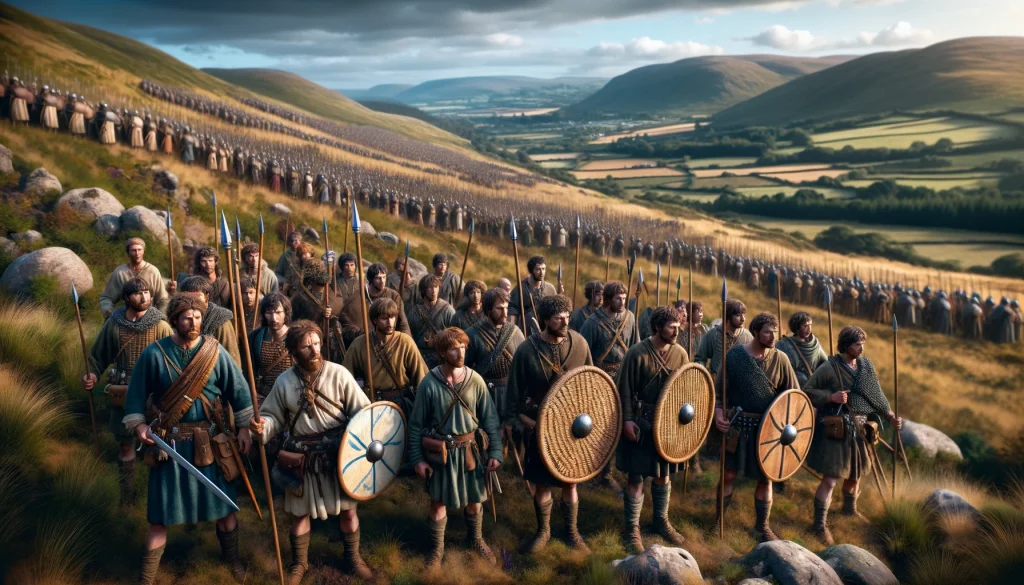
The battle started with a long-range exchange of missiles, a common tactic in ancient warfare. The Britons, skilled in the use of their massive swords and short shields, effectively parried or deflected the Roman projectiles while launching a significant number of spears at the Roman forces (Tac., Agr. 36.1).
The Romans, known for their disciplined military tactics, gradually gained control over the Caledonian chariots. This initial phase of the battle involved a volley of missiles, likely including light javelins that archaeologists frequently find at Roman military sites. These javelins, effective at distances up to about 30 meters (100 feet), would have been used alongside the auxiliaries’ heavier hastae (sturdy thrusting spears) to initiate the confrontation. This opening salvo set the stage for the ensuing battle, demonstrating the strategic deployment of various weapons by both the Roman and Caledonian forces.
Then Agricola exhorted the four Batavian and two Tungrian cohorts to fight hand to hand at sword’s point. They had trained for this during their long military service, whereas it was awkward for the enemy with their small shields and enormous swords, for the swords of the Britons, having no points, were
Tac., Agr. 36.1–2
not designed for grappling and close-quarters fighting. So the Batavians rained blows indiscriminately, struck with their shield-bosses, and stabbed in the face. When they had cut down those posted on the plain, they started to push their battle-line up the hillside. The other cohorts, in eager competition, pressed forward to attack, and cut down the nearest of the enemy. In the haste of victory, a good many were left half-dead or untouched.
Agricola placed significant trust in the Batavian and Tungrian troops during the Battle of Mons Graupius. These soldiers, known for their combat prowess, were key to his strategy. Whether they had already hurled their spears or not, each warrior drew his gladius, the quintessential short sword of the Roman army, and charged into the dense formation of the Caledonians. Their shields, constructed of plywood with brass trim and an iron boss, were not just defensive tools but also used offensively to strike the enemy.
This aggressive push by the Batavian and Tungrian soldiers sparked a surge in momentum across the Roman lines. Inspired by their example, other cohorts began to advance, stepping over the bodies of the fallen, indifferent to whether they were dead or alive in the heat of battle. During this intense phase, Aulus Atticus, a young prefect, lost his life. Tacitus attributes his death to his youthful zeal and an over-eager horse that took him too far into the enemy lines (Agr. 37.6). This incident underscores the chaos and peril of ancient warfare, where even a moment of overzealous action could have fatal consequences.
Meanwhile, the troops of cavalry fled and the charioteers (covinnarii) became embroiled in the infantry battle. But, though they had at first created panic, they began to falter in the crowded ranks of the enemy and the uneven ground. Such fighting was most disadvantageous to our men, maintaining their
Tac., Agr. 36.3 2
exhausted battle line for such a long time while being jostled by the horses’ flanks. And often, runaway chariots or terrified horses without their driver, as if guided by fear, dashed against them from the side or head on.
The deployment of the Caledonian cavalry during the Battle of Mons Graupius remains unclear, but it’s likely they were positioned on the flatter ground at the base of the hill, possibly intermingled with their infantry counterparts. Their eventual rout could be attributed to several factors, including possible disorganization and the lack of a unifying command structure. A critical element contributing to their defeat was Agricola’s strategic placement of 3,000 Roman cavalry on the flanks of his formation. These Roman cavalry units likely overpowered the Caledonian cavalry, leading to their retreat, which aligns with the primary role of cavalry in ancient warfare — to break through enemy lines and cause disarray.
Additionally, the Caledonian chariots, especially the scythed covinni, did not perform effectively in this battle. The design of these chariots required relatively level terrain to prevent the scythes from getting stuck in the ground. However, the terrain beneath Bennachie was uneven, posing significant challenges for their maneuverability. Furthermore, for the scythed wheels of the covinni to be effective, they needed to keep moving. But as the battle progressed, these chariots became largely immobilized, caught up in the melee with infantry. As the Roman line advanced steadily, the chaos caused by stray chariot horses and the obstruction from destroyed chariots only added to the difficulties faced by the Caledonian forces, hampering their ability to mount an effective resistance.
Throughout the Battle of Mons Graupius, the Romans skillfully managed to contain the conflict to the lower slopes of the mountain. This strategy prevented engagement on the more challenging, boulder-strewn upper slopes and drew Caledonian forces down into their range. However, Caledonian troops who were positioned on the hilltops, overlooking the battle and initially not engaged, began to descend to join the fray. Tacitus notes the strategic positioning of these forces on multiple hilltops, which resonates with the terrain of Bennachie, known for its several peaks (Tac., Agr. 37.1).
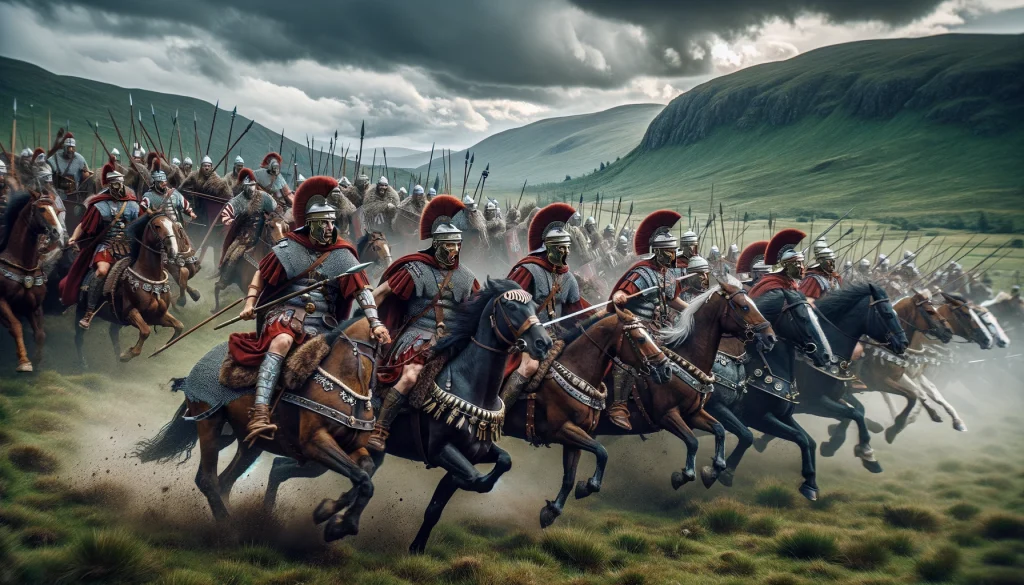
Anticipating this move, Agricola had reserved four regiments of cavalry for such emergencies. These units were then deployed to counter the Caledonians descending from the hilltops. By this time, the core Caledonian force likely suffered heavy casualties, leaving the remaining troops, possibly less experienced and poorly equipped, vulnerable. The Roman cavalry, being well-armed and armoured, effectively dealt with these new arrivals, turning the Britons’ strategy against them.
Tacitus describes a brutal scene where the Roman cavalry made short work of the Caledonian reinforcements, capturing and executing them in quick succession. The Britons’ attempt to outflank the Roman forces backfired as the Roman cavalry regiments were commanded to wheel around and charge the enemy’s rear ranks. This led to a chaotic and devastating scenario on the plains, with the Romans relentlessly pursuing, capturing, and killing the disorganized and isolated enemy forces (Tac., Agr. 37.2–3).
The account portrays a grim spectacle of the battle’s final phase, with the Roman cavalry dominating the field, cutting down fleeing groups of Caledonians and overtaking individuals who recklessly exposed themselves to danger. The battlefield was strewn with weapons, bodies, severed limbs, and blood, highlighting the ferocity and decisiveness of the Roman victory.
The Britons Rout
As the Britons began their retreat, marking the end of the battle, Agricola mounted his horse to lead the final operations. The fate of the Caledonian leader, Calgacus, remains uncertain. He might have been among the early casualties, particularly if he was one of the charioteer nobles.
Even in defeat, some Britons displayed fierce resistance. When they reached the woods, they regrouped and ambushed the overzealous Roman pursuers. To counter this, Agricola, ever vigilant, ordered agile cohorts to form a cordon around the area. In denser forest areas, some cavalry dismounted to continue the pursuit on foot, while in open areas, mounted troops swept through. These tactics were employed to prevent Roman casualties from overconfidence in their pursuit (Tac., Agr. 37.4).
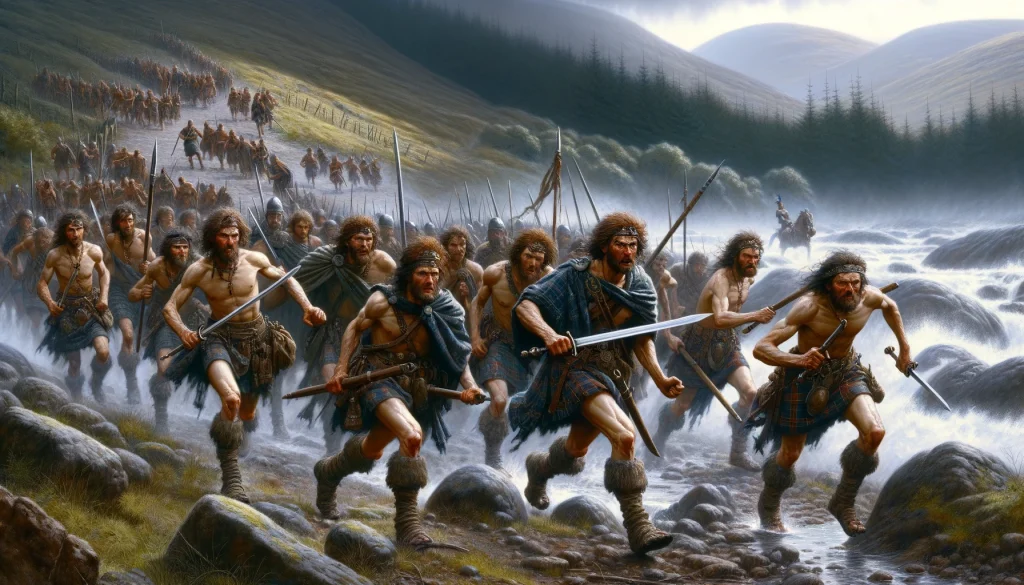
The end of the day’s operations was marked by darkness, with countless Britons fleeing without engaging in combat. Tacitus records that about 10,000 Britons were killed compared to 360 Romans, a figure that might have been exaggerated to emphasize the magnitude of the Roman victory. Despite the potential inflation of enemy casualties, it was common for the losing side in ancient warfare to suffer disproportionately high losses, mainly due to the effectiveness of the Roman cavalry in chasing down fleeing enemies. The reported figure of Roman casualties could have been verified from the detailed strength returns maintained by each regiment.
The aftermath of the battle was a night of celebration and looting for the victors, as battlefields typically provided ample spoils. The process of scavenging the battlefield likely continued for several days, with valuable items and weapons quickly claimed by the Romans. Tacitus describes the next day as revealing the full extent of the victory, with deserted landscapes and smoldering homesteads, and no sign of the enemy (Agr. 38.2).
The Roman camp at Durno likely remained active for days or weeks post-battle, serving various purposes such as medical care for the wounded, equipment repair, and prisoner containment. Traditional practices like erecting a trophy to claim ownership of the battlefield and arranging burials for the fallen Romans were also carried out. Tacitus provides an apt epitaph for the Roman dead, suggesting the honor in dying at the edge of the known world (Tac., Agr. 33.6).
